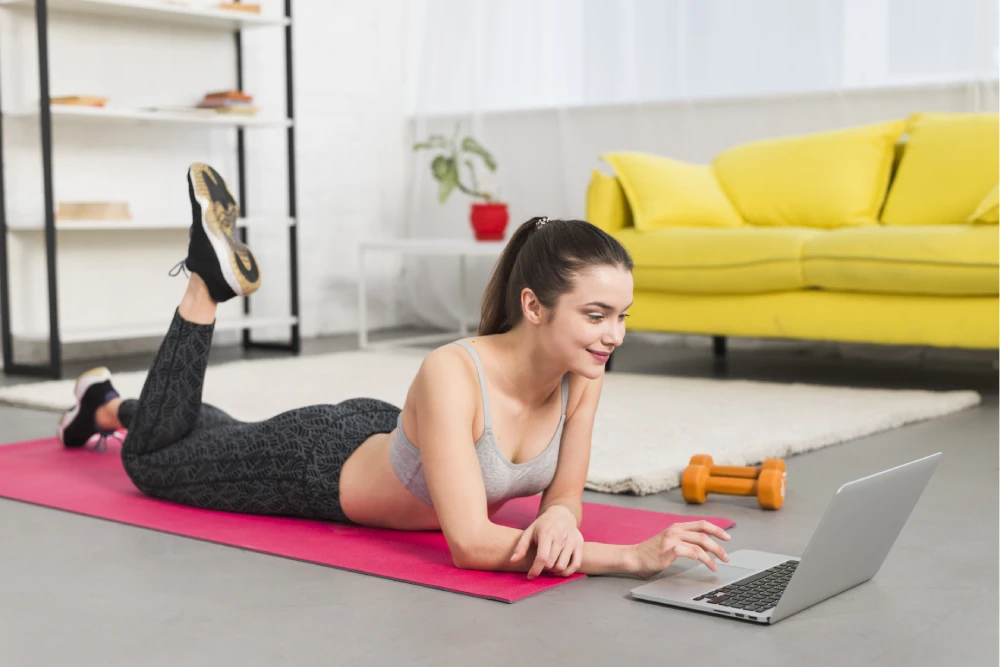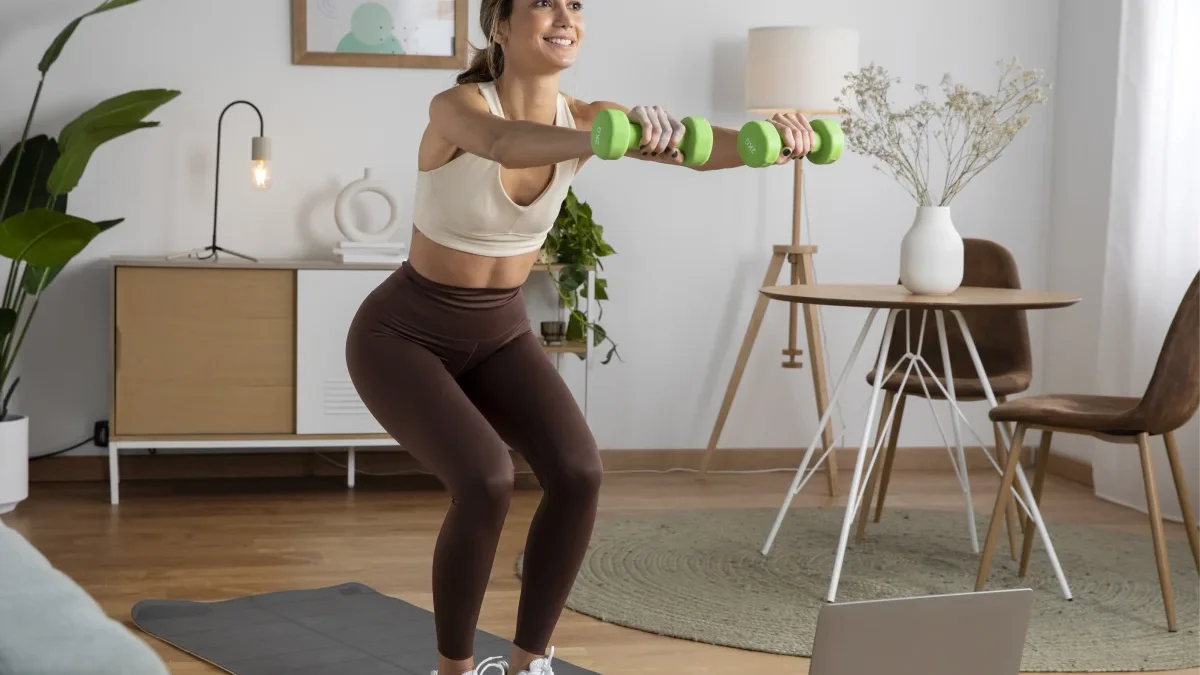According to a poll by CivicScience, 52% of adults in the U.S. say they exercise regularly (either weekly to monthly) at home, while only 28% of adults exercise regularly at the gym. It’s clear people want to work out at home for many reasons instead of going to the gym. Whether they want to avoid crowds, save money on gym memberships, or enjoy the flexibility of working out on their own schedule, home workouts are growing more popular.
Your home workout environment can be tailored to your needs, and the workouts you choose should be tailored to your fitness level. You don’t want to initially push yourself too hard or too far, or you might find yourself injured and back on the couch. Start slow and go carefully; you will get stronger and fitter as you gain strength and endurance, which will help you to avoid injuries.

Table of Contents
Beginner At-Home Workout
As a beginner, think about your basic exercise goals when starting out. You may want to build your strength, your endurance, or both. Here are four exercises you can do at home as a beginner. Aim for two sets of ten for each exercise and add sets as you’re able:
- Push-ups: Push-ups strengthen your arms, chest, and core. Using a mat or on carpet, begin by placing your hands on the floor, palms down, at shoulder width. Align your body in a straight line. If you need to use your knees, that’s fine, but keep your shoulders, arms, and core as straight as possible. Lower your chest and raise it slowly and under control. Aim to do two sets of push-ups to begin, moving up to three sets of 12 reps.
- Lunges: Lunges strengthen your glute muscles and thighs. Using a chair, counter, or wall for balance, take one big step forward and balance on your front heel. Lower your body until your front leg forms a 90-degree angle, and your back leg lowers as much as possible toward the floor. Push off and return to the starting position, then alternate each leg. Aim to begin two sets of ten lunges, moving up to three sets of 12 reps.
- Squats: Squats strengthen your entire lower body, including your quadriceps, hamstrings, glutes, and thighs. Placing your feet apart at shoulder width, extend your arms for balance. Tighten your core, and keep your chest and shoulders aligned. Keeping your weight on your heels, lower your butt as if you’re sitting in a chair. Squat until your thighs are parallel to the ground. Aim to begin two sets of ten squats, moving to three sets of 12 reps.
- Planks: A plank strengthens your abdominal and back muscles. It begins in the same position as a full push-up, but instead of moving, you keep your body still and back straight. Start by holding the plank position for at least 15 seconds and work until you can hold it for 30 seconds or longer. Aim to begin two sets of 10 planks, moving to up to three sets of 12 reps.
Intermediate At-Home Workout
Once you’re comfortable with basic exercises and can increase your intensity, try your hand at a few intermediate at-home workouts. Remember to consider your longer-term goals for fitness, and whether you want to build more strength, improve your cardio health, or both.
- Video workouts: You can find 20-to-40 minute video cardio workouts, such as on Youtube, which can be done at home in a small space. You’ll be moving your body along with music and guidance and can use weights. Start with about 20 minutes, aiming for a target heart rate of 50 to 70% of your maximum heart rate. To determine your max heart rate, subtract your age from 220. For example, if you’re 40, your max heart rate is 180.
- Biceps curls: If you have dumbbells, you can use them for this exercise. If not, soup cans or water-filled bottles can stand in. Standing with your legs separated and looking in a mirror, hold the dumbbells with your palms up and slowly raise and lower your arms. Start with two sets of 10 reps, and advance to three sets of 12 reps before advancing to a heavier weight.
- Lateral raises: With your dumbbells or homemade weights, start with your arms at your sides, with hands facing inward. Lift both arms straight up to shoulder height, then lower them slowly. Focus on control; if your elbows are bent, you should move down in weight. Start with two sets of 10 reps and advance to three sets of 12 reps before moving up to a heavier weight.
- Wall squats: Stand with your back to the wall and lower yourself to a seated position without a chair. Hold the position for 10 to 20 seconds. As you become stronger, hold the position longer, and repeat for one set of 10 and up to 2 sets of 10 or 12.
Advanced At-Home Workout
If your cardio health has advanced and you can perform at least 30 minutes of cardio exercise without growing too tired and can also easily complete the beginner and intermediate exercises, try out these more advanced workouts that focus on coordination, balance, endurance, and strength. For these workouts, you’ll only need resistance bands and exercise balls.
- Stability ball push-ups: Use an exercise ball, and instead of doing push-ups on the floor, balance your hands on the ball at shoulder width. Using your balance and core strength, perform two sets of 10 stability ball push-ups, advancing to three sets of 12.
- Banded side steps: If you’ve been doing video cardio workouts, you’ve probably already done side steps. To these, use an exercise band around your lower legs at the ankle. Don’t use too much resistance to start; a minimum resistance band is a good starting point. Start by doing five steps to the right, then five steps to the left, and repeat for three sets, advancing to more resistance and a higher number of sets as you become stronger and more flexible.
- Lunges with weight: Continue with your lunges while holding dumbbells by your side or a medicine ball in front of you. Begin with two sets of 10 and advance to three sets of 10 or 12 reps.
- Increased cardio: Work to extend your cardio sessions beyond half an hour. Consider investing in a fitness tracker to monitor your workouts, performance, and metrics like VO2 Max, which measures how much oxygen your body can use during intense exercise.
Tips on Improving Your Fitness Level
No matter where you start, you can become fitter and stronger. And, no matter what fitness level you’ve achieved, a protein bar after your workout, along with plenty of water, will help your muscles recover. Along with home workouts, you can help the process by getting enough restful sleep, eating more nutritious, high-protein food, and using a fitness tracker to show how much you’re advancing. With a game plan and solid nutrition, you can tackle your at-home workouts with confidence.

